#biennale of sydney 2024
Text




William Strutt (1825-1915) UK
Black Thursday, February 6th, 1851 (1864)
oil on canvas
#Strutt#William Strutt#biennaleofsydney#biennale of sydney 2024#fire#bushfire#Kulin Nation#biennalesydney
0 notes
Photo

The Trailblazing Sculptor Shaping the African Diaspora... Artwork by Alison Saar, Sculptor. IG: @alison_saar www.alisonsaar.com Alison Saar, an eminent sculptor, mixed-media, and installation artist, has carved her way through the contemporary art world with her evocative works that delve into themes of the African diaspora, spirituality, and black female identity. Born in 1956 to acclaimed artists Betye and Richard Saar, her upbringing amidst the flourishing art scene in Los Angeles and an early exposure to African American and African diaspora art fostered her unique artistic vision. Saar's artistic career has been shaped by the influences of significant artists like her mother, Betye Saar, John T. Riddle Jr., and Samella Lewis. Her artwork, characterized by the use of found objects and an evocative play of materials, resonates with a deep understanding of the histories and cultures she draws inspiration from. Saar's powerful sculptures and installations, such as "Topsy Turvy" and "Weight," highlight her ability to capture the complexity of the black experience, often imbued with themes of resilience and defiance. Her ongoing "Coup" series is a testament to her remarkable sculpting prowess, featuring wooden figures donning gas cans and weaponry, symbolizing the struggle for liberation and resistance against oppression. Beyond the United States, Saar's influence as a leading black sculptor is evident in her participation in international exhibitions like the 5th Biennial of African Contemporary Art in Senegal and the 2022 Sydney Biennale. Most recently, Saar's immense talent and cultural influence have been recognized by her commission to create a public sculpture for the Paris 2024 Olympics. The artwork, titled "Victory," honors the contributions of African American soldiers who fought in World War II. Saar's continuous exploration of black history and the diaspora has solidified her standing as a key figure in contemporary art, making her an inspiration for many emerging artists.
0 notes
Text
Gallery visit: MOMA (6.7.24) - PART 4
Exhibition description (found in all other exhibition locations for 24th Sydney Biennale): "Change - or mudança in Tadaskía's native language of Brazilian Portuguese - lies at the center of the multidisciplinary artist's practice. In her work across drawing, sculpture, and other media, Tadáskía employs an improvisational approach, conveying a sense of fluidity through her dynamic mark-making, nuanced imagery, and kaleidoscopic palette. Rather than pursue a complete or final image, the artist has explained: "I'm interested in the passage from one thing to another."
Tadaskia's unbound book ave preta mística mystical black bird (2022) forms the centerpiece of this presentation. The work recounts a fantastical tale of "winged transformation," and pairs the artist's freeform drawings alongside her poetic, bilingual text. The images depicted in her colorful compositions, which she often initiates with closed eyes, vary and morph from one sheet to the next. They might appear as crescent moons and brilliant suns, or as ambiguous abstract shapes. Through the story, we are invited to follow its titular ave preta, or black bird, on her flight across earthly and divine realms, "towards a journey of freedom," informed by the artist's lived experience as a Black trans woman.
For Projects: Tadáskía, the artist has produced an expansive wall drawing and a set of sculptures in response to this exhibition space.
While her vigorous mark-making encourages us to trace her coursing and shifting lines, the organic materials used in her sculptures evoke the ephemeral life cycles of nature. Alongside the central role of change, as Tadáskia herself asserts, "the main character in the work is time.""

ave preta mística mystical black bird (2022, unbound illustrated book (pencil, colored pencil, oil pastel, and spray paint on torn paper, 61 sheets) - excerpt below)






Description: "While briefly hospitalized as a child, Tadáskía discovered reading, writing, and drawing as ways to imagine community. This work was inspired in part by a storybook she received during her hospital stay, and in the artist's words, serves as "a fable, but without the moral." The hopeful tale is also influenced by the writings of Black feminist thinkers like Audre Lorde. It begins with a dedication to her "Black sisters and Black brothers," to "Black women and Black trans people," as well as to "people who care about children and to people who are equally children at heart.""
Row 1: animated play Ill (brincando animada lIl) (2023/2024, mural - charcoal and dry pastel on wall)
Row 2: arrangement (arranjo) (2019/2024, diptych sculptural installation - bamboo, beachgrass, willow branches, wire, beads, eggshells sewn with gold thread, face powder, black liquid, clear liquid, plates, fruits, and vegetables on platforms with charcoal and dry pastel)





Description for animated play Ill (brincando animada lIl) (2023/2024): ""When I was drawing, my mother, Elenice Guarani, and my aunt, Gracilene Guarani, who are both Black, Afro-Indigenous women, told me to add more color because color is life," the artist has said. From her earliest art-making experiences as a child, collaboration has been a central aspect of Tadáskia's practice. To
produce this large wall drawing, she worked with a team of assistants over several weeks as they built up its prismatic palette."
Description for arrangement (arranjo) (2019/2024): "In keeping with her improvisational approach, Tadáskia's sculptures are made in response to the exhibition site. She approaches their creation with an openness to materials - often organic - that will continue to change over time. Raised in the Pentecostal church, the artist sometimes incorporates objects, including cattails, beads, or stones, that are significant within various Afro-Brazilian religions like Candomblé. Her choice of materials derives from the relative magnetism of certain elements: "There is a vibration in things and people we meet, which sometimes pulls together, sometimes pulls apart.""
0 notes
Text
DAY 2
Date: March 28, 2024
Time: 12:00 PM - 6:00 PM
Location: Kimber Street Studios, 5 Kimber Street, Paddington, New South Wales 2021
Participants: Francis, Zinnia, Sida
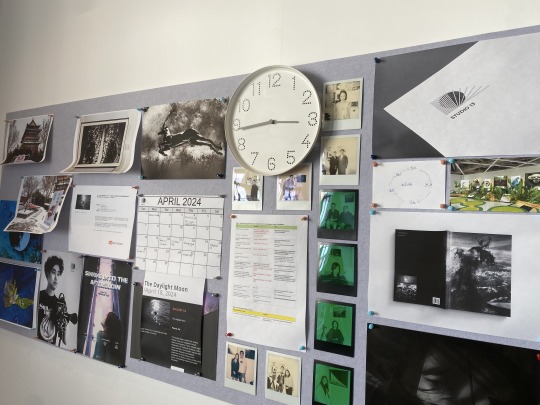

Overview:
Today's work focused on deeper collaboration following initial familiarization. The emphasis of the day was on content generation, aimed at preparation for upcoming exhibitions.
Chronological Entries:
- 12:00 PM - 1:40 PM: Mid Journey Practical Sessions
- Francis instructed on setting up a personal server on Discord and adding bots for private creation.
- Learned to create prompt keywords, further filtering and saving images.
- Utilized community browsing to gather prompts and creative inspiration.
- 1:40 PM - 2:00 PM: Indesign Roomsheet Layout Design
- Utilized templates established last week to format English and Traditional Chinese manuscripts provided by Zinnia into complete exhibition invitations for print and email distribution.
- 2:00 PM - 2:20 PM: Break
- Francis shared experiences from non-film festival competitions he participated in, including insights into the Sydney Biennale.
- 2:15 PM - 3:30 PM: Indesign AVALON Layout Design
- Enhanced previous week's design, adding more photos and adjusting photo presentation sizes.
- 3:30 PM - 6:00 PM: ZEN Sound Design
- Communicated sound design ideas for Francis's upcoming exhibition and desired concepts.
- Preliminary screening of sound effect libraries and finding reference sounds.
- Produced a 1-minute 30-second sound design based on reference sounds, achieving seamless loop transitions.
Skills Learned and Application:
During today's internship, I learned to utilize AI tools to enhance work efficiency, particularly in communication. Starting with Mid Journey to quickly generate several concepts, which were then presented to the client for direction selection, followed by detailed design and modification. Additionally, through trial and error, I resolved the issue of errors displaying when exporting PDFs from InDesign, caused by Chinese fonts. Henceforth, especially in bilingual environments, efforts should be made to avoid mixing Chinese and English in the same document. This not only addresses workflow issues but also significant differences in Chinese font formatting. Furthermore, given the studio's frequent need for both Simplified and Traditional Chinese formats, I should familiarize myself with commercially usable fonts supporting PDF export in both forms to expedite future workflows.

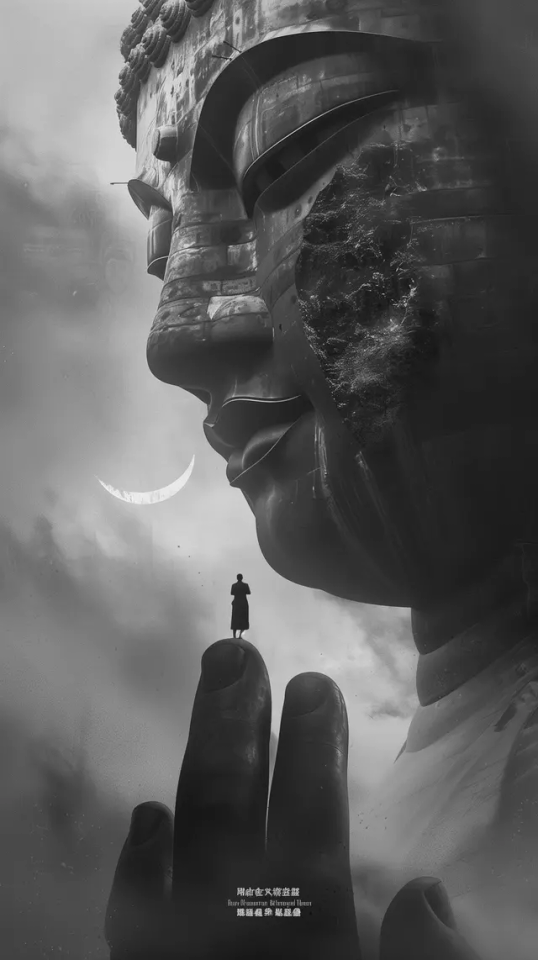
(Mid-Journey Generated Photo)
Analysis of Interviews and Events:
Francis shared experiences from film festivals and competitions he participated in. Particularly interesting was EQUS's art creation on quantum science held at M2 Gallery last year, which excitedly combines art with physics. Moreover, this serves as a good means to connect with local artists through the numerous galleries and their regular events. This aspect, which I seldom considered during my student career, involves broadening my social circle beyond school, yet it's precisely what I need once detached from school's protection. Additionally, Francis mentioned that due to technological limitations, XR and VR are still relatively niche fields with high chances of winning awards at film festivals. Therefore, considering VR film production when I can still borrow XR equipment from school.

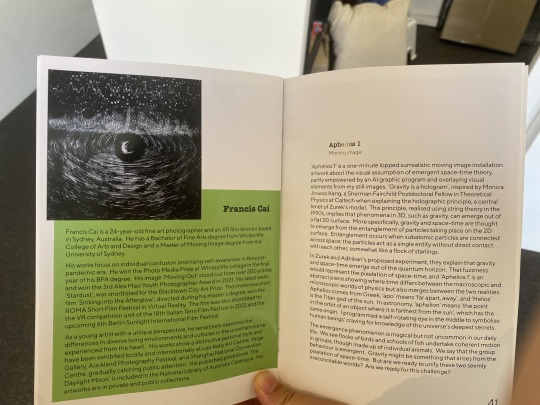
Reflections on Experiences:
Overall, today involved deeper collaboration and my first independent sound design within a limited time frame. This made me feel pressure stemming from insufficient skills and preparation. Hence, I will continue to refine my sound design techniques, especially in synthesizers. This being my first opportunity to participate in exhibition sound design, I shouldn't easily let go of this hard-earned opportunity.
Next week, I'll complete the design of the Avalon spine layout and export versions suitable for printing. Furthermore, I'll refine the installation's sound design. Simultaneously, I should start brainstorming the direction of my research paper and begin preparations accordingly.
0 notes
Text
Art World This Spring: 5 Must-See Exhibitions Around the Globe

Hit the refresh button on winter! Spring's here and the art world is buzzing. Dive into thought-provoking realness at the Whitney Biennial, or journey into the mind-bending quantum world in Switzerland. Prepare to be surprised and inspired by these must-see exhibitions!
Whitney Biennial 2024: Even Better Than the Real Thing (New York)
20 Mar – 11 Aug
This year's Whitney Biennial promises a fresh look at the concept of "real" in art. Curated by a diverse team, the exhibition features established and emerging artists questioning boundaries and exploring themes of identity, technology, and social issues. Look out for feminist heavyweights like Harmony Hammond, established names like Isaac Julien, and fresh perspectives from artists like Mongolian filmmaker Zulaa Urchuud.
For more visit> 20 March–11 August
Libby Heaney: Quantum Soup (Basel)
23 Mar – 26 May
For a truly mind-blowing experience, head to Switzerland to see Libby Heaney's groundbreaking work. This scientist-turned-artist utilizes quantum computers to create immersive installations and experiences that offer a glimpse into the fascinating world of quantum physics. Prepare to be dazzled by futuristic digiscapes that defy conventional logic.
For more visit> 23 March–26 May
24th Biennale of Sydney: Ten Thousand Suns (Sydney)
9 Mar – 10 Jun
This year, the Sydney Biennale embraces optimism in the face of global challenges. "Ten Thousand Suns" celebrates resilience and joy through the diverse practices of 88 artists from around the world. Expect to be inspired by works that explore Indigenous knowledge, community, and resistance in a vibrant and hopeful exhibition.
For more visit> 9 March–10 June
Yokohama Triennale: Wild Grass: Our Lives (Yokohama)
15 Mar – 9 Jun
Inspired by the perseverance of wild grass, the Yokohama Triennale delves into humanity's ability to overcome adversity. This wide-ranging exhibition features 94 artists tackling themes of social and political turmoil, climate change, and inequality. Be prepared for a thought-provoking exploration of resilience in the face of global challenges.
For more visit> 15 March–9 June
Miranda July: New Society (Milan)
7 Mar – 14 Oct
Get ready for a multifaceted experience with Miranda July's first solo museum exhibition in Milan. This multi-talented artist explores themes of intimacy, human connection, and feminism through a diverse range of media. Discover sculptures, video installations, her entire filmography, and a brand-new video piece titled "F.A.M.I.L.Y."
For more visit7 March–14 October
So, art lovers, pack your bags and get ready to embark on a journey of discovery! With these incredible exhibitions around the globe, there's no shortage of inspiration to be found this spring.
Read the full article
0 notes
Text
Sheelasha Rajbhandari & Hit Man Gurung
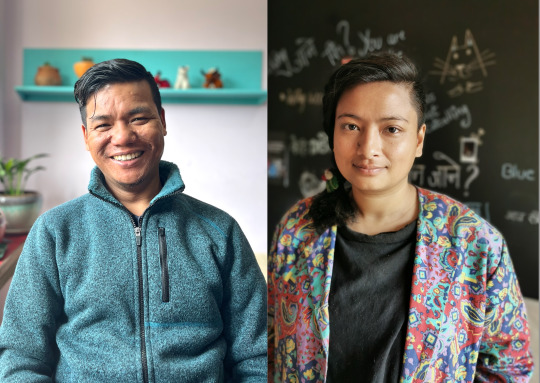
Mardi 12 décembre 2023 à 17h (heure de Paris)
Tuesday December 12th 2023, 5pm (Paris time)
Co-commissaires de la 17e Biennale Jogja 2023 et de Colomboscope 2024 / Co-curators for 17th Biennale Jogja 2023 and Colomboscope 2024
Sheelasha Rajbhandari (née en 1988) est une artiste et une curatrice opérant partir de Katmandou. Ses travaux s'appuient sur une lignée de féminités incarnées et spéculatives pour remettre en question le positionnement des femmes à travers le temps, les paysages et les cosmologies. Sa pratique incite à réfléchir au-delà de la conception néolibérale du temps, afin de décentrer les structures patriarcales qui perpétuent les cycles d'extraction industrielle et d'épuisement individuel. Pour elle, l'art consiste à créer un espace pour l'action collective. Ce questionnement alimente sa récente approche artistique et curatoriale qui recompose les notions d'indigénéité, de genre, de valeur et de productivité. Elle a été co-commissaire de la Triennale Katmandou2077, du Pavillon du Népal à la Biennale de Venise (2022), de "Garden of Ten Seasons" à Savvy Contemporary, Berlin (2022) et de "12 Baishakh", Bhaktapur (2015) aux côtés de Hit Man Gurung. Son installation textile a été exposée au Museum of Art and Design de New York (2022) et au Footscray Art Center de Melbourne (2022). Son installation dans l'exposition itinérante " A beast, a god and a line " (2018-2020) a été présentée à Para Site, Hong Kong ; TS1, Yangon ; Museum of Modern Art, Varsovie ; Kunsthall, Trondheim ; et MAIIAM Contemporary Art Museum, Chiang Mai. Elle a également été artiste en résidence au Bellas Artes Projects (2019) et au Para Site (2017). Elle a en outre exposé au Weltmuseum Wien (2019) et à la Triennale de Katmandou (2017). Dans le cadre de son collectif, elle a participé au Dhaka Art Summit (2020) et à la Biennale de Sydney (2020). Elle est également cofondatrice d'ArtTree Nepal, un collectif d'artistes, et d’un espace artistique, Kalā Kulo.
Hit Man Gurung (né en 1984) est un artiste et un curateur basé à Katmandou. Ses diverses pratiques s'intéressent au tissu des mobilités humaines, aux frictions de l'histoire et aux échecs des révolutions. Bien qu'ancrés dans l'histoire récente du Népal, ses travaux démêlent un réseau complexe de liens de parentés et d'extractions à travers les géographies qui soulignent l’exploitation inhérente au capitalisme. Ces récits tournent autour des expériences vécues par les migrant·e·s, pris·e·s entre une industrie transnationale déshumanisante fondée sur le travail, et un État-nation apathique. Il invoque en outre les méthodologies et épistémologies indigènes pour reconfigurer dans ses fondements la praxis artistique contemporaine. Il a été co-commissaire de la Triennale de Katmandou2077 (2022), du Pavillon du Népal à la Biennale de Venise (2022), de "Garden of Ten Seasons" à Savvy Contemporary, Berlin (2022) et de "12 Baishakh", Bhaktapur (2015), aux côtés de Sheelasha Rajbhandari. Il a également cofondé ArtTree Nepal, un collectif d'artistes, et l’espace artistique Kalā Kulo. Il a participé à des expositions à SAVVY Contemporary, Berlin (2020) ; Biennale de Sydney (2020) ; Artspace Sydney (2019) ; Weltmuseum Wien (2019) ; Kathmandu Triennale (2017) ; Yinchuan Biennale (2016) ; Para Site, Hong Kong (2016) ; Asia Pacific Triennial of Contemporary Art, Brisbane (2015-16) ; et Dhaka Art Summit (2014, 2016, 2018, 2020).
[EN] Sheelasha Rajbhandari (b. 1988) is an artist and curator based out of Kathmandu. Her works draw upon an embodied and speculative lineage of femininities to question the positioning of women across time, landscapes, and cosmologies. Her practice is a provocation to reflect beyond neo-liberal conception of time in order to decenter patriarchal structures that perpetuate cycles of industrial extraction and individual exhaustion. For her, art-making is about making space for collective action. This questioning feeds into her recent artistic and curatorial approach that recompose notions of Indigeneity, gender, worth, and productivity. She co-curated the Kathmandu Triennale 2077, Nepal Pavilion at Venice Biennale (2022), ‘Garden of Ten Seasons’ at Savvy Contemporary, Berlin (2022) and ’12 Baishakh,’ Bhaktapur (2015) alongside Hit Man Gurung. Her textile installation was exhibited at Museum of Art and Design; NewYork (2022), Footscray Art Center; Melbourne ( 2022). Her installation in the traveling exhibition “A beast, a god and a line” (2018-2020) was presented at Para Site, Hong Kong; TS1, Yangon; Museum of Modern Art, Warsaw; Kunsthall, Trondheim; and MAIIAM Contemporary Art Museum, Chiang Mai. She has also been an artist in residence at the Bellas Artes Projects (2019) and Para Site (2017). She has furthermore exhibited at Weltmuseum Wien (2019); and Kathmandu Triennale (2017). As a part of her collective, she has been a part of Dhaka Art Summit (2020) and Biennale of Sydney (2020). She is also the co-founder of ArtTree Nepal, an artist collective and Kalā Kulo, an arts initiative.
Hit Man Gurung (b. 1984) is an artist and curator based in Kathmandu by way of Lamjung. Gurung’s diverse practice concerns itself with the fabric of human mobilities, frictions of history, and failures of revolutions. While rooted in the recent history of Nepal, his works unravel a complex web of kinships and extraction across geographies that underscore the exploitative nature of capitalism. These narratives revolve around the lived experiences of migrants caught between a dehumanizing transnational labor-based industry and an apathetic nation-state. He furthermore invokes Indigenous methodologies and epistemologies to fundamentally reconfigure contemporary artistic praxis. Gurung is one of the curators for 17th Biennale Jogja 2023 and Colomboscope 2024. He was co-curator for the Kathmandu Triennale 2077 (2022), Nepal Pavilion at Venice Biennale (2022), ‘Garden of Ten Seasons’ at Savvy Contemporary, Berlin (2022) and ’12 Baishakh,’ Bhaktapur (2015) alongside Sheelasha Rajbhandari. He has also co-founded ArtTree Nepal, an artist collective and Kalā Kulo, an arts initiative. He has participated in exhibitions at SAVVY Contemporary, Berlin (2020); Biennale of Sydney (2020); Artspace Sydney (2019); Weltmuseum Wien (2019); Kathmandu Triennale (2017); Yinchuan Biennale (2016); Para Site, Hong Kong (2016); Asia Pacific Triennial of Contemporary Art, Brisbane (2015-16); and Dhaka Art Summit (2014, 2016, 2018, 2020)
Programmation et prochains rendez-vous sur ce site ou par abonnement à la newsletter : [email protected]
Pour regarder les séminaires antérieurs : http://www.vimeo.com/sysk/
Séminaire conçu et organisé par Patricia Falguières, Elisabeth Lebovici et Natasa Petresin-Bachelez et soutenu par la Fundación Almine y Bernard Ruiz-Picasso para el Arte
1 note
·
View note
Video
undefined
tumblr
Dear Fran,
Well its been a bit hectic hasn't it? That whirlwind trip to install at ANCA with you all was so nice. I know you were stressed but I was having a great time. I do enjoy thinking about how people move through space and interact with it. I’m glad there was at least one shelf that sparked conversations about height and viewing, and I think it only enhances the connections your works have to those tomb niches below the earth...so! A success to say the least!!! How have the workshops and the weekends been by the way? Its just such a weird location that I’m curious about visitation.
Speaking of things being hectic and feeling rushed and the sense on impending doom, me too. I had the horrid realisation last week that I’m halfway through my 6month contract at the Biennale and now I have to start advocating for myself to stay. This is an immensely hard task, and one that I struggle with. I hate having to ask for things that I want or need, it truely makes me squirm and feel so icky and revolting. Not to mention that I’ve been having a few imposter syndrome flair ups and thats not helping my mood. I guess you could say I overdid it that week in CBR and then coming back to Sydney and going straight to work. I think I’ve burnt out a bit...
Another thing that I’ve been realising over the past couple of weeks is that the shock of dad’s death has worn off, and now I’m just incredibly sad. Its like a forlorn monster just slumbering inside my ribs at the very top there, just above the heart. A greyish-purple fuzzy, droopy thing. On the plus side I no longer feel concussed! WOO! A major win in my books. That was fucked.
Anyway I was thinking about the exhibition and your work and how this time last year we were gearing up to start this blog with Mayspace. I was thinking about all the digital works I made as part of that and how fun it was, so I just started playing an image of your work. I chose purple and orange because they seemed very you colours....I know you’ve seen some of the others but this little video (I hope it works oh god) was one of those experiments. Of course it ended up a kaleidoscope type flower. Naturally.
I am a bit bummed out about the exhibition at Belco arts being pushed back to 2024 but maybe its for the best? I guess i just wanted something with a tangible outcome to aim for, to kickstart my drive again. Also re your piece, I love the bronze glaze too and I hope you’ve entered it! I think things like that are great platforms for trying out new ideas because you get such good feedback.
Take care and chat soon!
xxxxx Zoe
0 notes
Text







Dr Destiny Deacon (1956-2024) Kuku Yalanji and Erub/ Mer Australian
1-4 details of Blak Bay (2023-4) photographic media, light boxes
exhibited at Biennale of Sydney 2024
5 Me and Virginia's Doll (1995) photograph image: 31.8x25.1cm
6 Come to my Kitchen (2009) photograph image: 80x60cm
7 Baby love (from 'Forced into images' portfolio) (2001) 119x101cm Bubble jet print from polaroid photograph on paper
www.biennaleofsydney.art
A www.biennaleofsydney.art/participants/destiny-deacon/
Dr. Destiny Deacon was from the KuKu and Erub/Mer peoples of the Torres Strait Islands and lived in Melbourne most of her life. Her multi-disciplinary practice – across photography, film, sculpture, performance and installation – was forged from personal family and community stories that enveloped her urban playground. As well as being an artist, she was also a respected activist, performer, writer and broadcaster.
Deacon’s intriguing works continually provoke, challenge and reimagine the Aboriginal narrative through the photographic lens. She intuitively engages her audience through an exchange of ideas, stories and approaches to thinking with works that often have a subtle political guise. Using satirical black/blak humour she interrogates and explores the tales, events and imagined lives of Aboriginal and Torres Strait Islander people.
B artgallery.nsw.gov.au
...she considers the casual cruelty of everyday racism with a humour particular to her identity. Jokes mostly rely on mocking the weak, yet in Deacon’s twisted currency one cannot be quite sure who is the joker and who the joke is on. Deacon’s anti-art is seemingly slapdash, but is in fact thoroughly cunning. She describes herself as ‘just a crappy artist’, and has said that the ‘worse’ the art – the more unfocused or uneventful – the tougher its impact. ...
C artreview.com
Indigenous Australian multimedia artist Destiny Deacon (of K’ua K’ua/Kuku and Erub/Mer descent) is best known internationally for her photographs that depict friends, family and kitsch artefacts in unsettling and surreal scenarios that describe Indigenous trauma, memory, identity and cruelty via the artist’s characteristic visual language of ‘Blak humour’. Among the photographed objects, her collection of Aboriginalia (which she calls ‘Koori Kitsch’) and black dolls are her most frequent muse: “I feel sorry for those little dolls lying in trash and treasure markets… looking all forlorn and stuff. I don’t know why – I just seem to rescue them,” .... The term was coined by Deacon (and is also often traced to her photographic triptych Blak lik me, 1991) and continues to be used by Indigenous communities in Australia as a means of self-determination. Its specificity lies in the reclamation of the word ‘Black’, understood by Deacon to be a concept imposed on Indigenous people by the continent’s colonisers, where the omission of the letter ‘c’ transforms it into a term that is now used to describe contemporary Aboriginal culture, history, art and shared social experiences, rather than racial categorisation.
#Dr Destiny Deacon#Deacon#biennaleofsydney#Biennale of Sydney 2024#White Bay Power Station#blak#White Bay
1 note
·
View note
Text












Biennale of Sydney 2024, White Bay Power Station site
© optikestrav
1 note
·
View note
Text



Doreen Chapman (b1971) Jigalong (Pilbara region, Western Australia)
Manyjilyjarra people
Untitled (2023) acrylic on canvas
Untitled (2023) acrylic on canvas
A tracksweshare.com.au
Doreen’s story as told by her mother Maywokka (Mayiwalku) Chapman.
Been born Jigalong. Big sister for my son, Dennis Thomas. He been come this way, Hedland. Doreen, and me, are from Karntimarta, Warralong. I been bring him here. Little girls he start painting, in Warralong. He looking … looking … he quick painter, quickly, looking, looking. No fishing, no hunting, no car, painting, painting every day eh? You been bring ‘em, he painting, painting, painting!
B jardan.com.au
Profoundly deaf since birth, Chapman is a non-verbal artist. Doreen spends most of her time in Warralong community and visits Port Headland to see family and paint her bold and arresting works at the Spinifex Hill Studios. Her paintings explore the interplay of tradition and contemporary culture, where past and present co-inhabit space and time. ...
As a deaf woman, ‘painting is a crucial form of her communication and storytelling’. Doreen is an ambidextrous painter who mainly uses round brushes, fingers and thumbs to complete large format works.
C Gina Fairley artshub.com.au
At each of the multiple venues presenting the 24th Biennale of Sydney, visitors are greeted by a brightly coloured painting of an ATM: the works of Manyjilyjarra woman Doreen Chapman (Jigalong, WA), a non-verbal, deaf artist known for her uninhibited painting style.
These ubiquitous machines represent a point of transaction – a transfer of currency – and, when placed within an artistic vernacular, one can’t help feel that Artistic Directors Cosmin Costinaș and Inti Guerrero are asking the question, “at what cost does culture come to us?” and reminding us of the value of creative exchange.
It is a wry and sensitive entry point, given that it is easy to feel jaded by these big, spectacular exhibitions, which take on so much and yet often fall back on familiar names doing the global “biennale circuit” – a kind of “art world currency”, to pick up on Chapman’s ATMs.
2 notes
·
View notes
Text





Carrolup child-artists, Western Australia
reading:
www.carrolup.info
#Carrolup#2024 biennaleofsydney#Biennale of Sydney#Western Australia#childrens drawings#drawing#biennalesydney
0 notes
Text
Gallery visit: 24th Sydney Biennale (AGNSW) (4.4.24)
Exhibition description (found in all other exhibition locations for 24th Sydney Biennale):
"The singular life-giving body that is the sun, like the world it shines light upon, has been known under thousands of different words
in as many languages. Each name carries a different cultural viewpoint, and many do not rely on a vision of a single sun. The image of ten thousand suns evokes a scorching world, both in cosmological visions and in our present moment of climate emergency and of a world ablaze.
Since 1945, the atomic era has aroused the public imagination. Nuclear explosions have been inscribed in memory in the form of devastatingly monumental mushroom clouds. This history largely unfolded in the Pacific, from the bombs dropped on Japan during the Second World War to the hundreds of tests staged in the subsequent decades, orchestrated by imperial powers on island nations and Indigenous lands. The race to develop nuclear weapons has caused human displacement and contamination, and led to regimes of military control, including at Maralinga, South Australia, from 1952 to 1963. Unlike the nuclear era, the manifold crises of the carbon era remain elusive and are not able to be encapsulated in a single image. Thus, the mushroom cloud also asks how the climate crisis can be imagined, represented and embodied in the life of images.
Across all sites, the 24th Biennale of Sydney emphatically conveys a "solar joy' of cultural multiplicities. It brings First Nations understandings of the cosmos to the fore, and celebrates carnival traditions as forms of resistance and modes of rallying against oppression and dehumanisation. Under the title Ten Thousand Suns, the Biennale works within these different layers, acknowledging the deep crises derived from rampant exploitation while refusing to concede to an apocalyptic vision of the future. This edition cautions against a 'politics of doom' as a cause for fatalism and inaction. It proposes, instead, the radiance and warmth of ten thousand suns, illuminating a collective future lived with irrepressible joy that is not only possible, but also necessary."
Maru Yacco's Sydney Parade (2024, mural - acrylic paint)


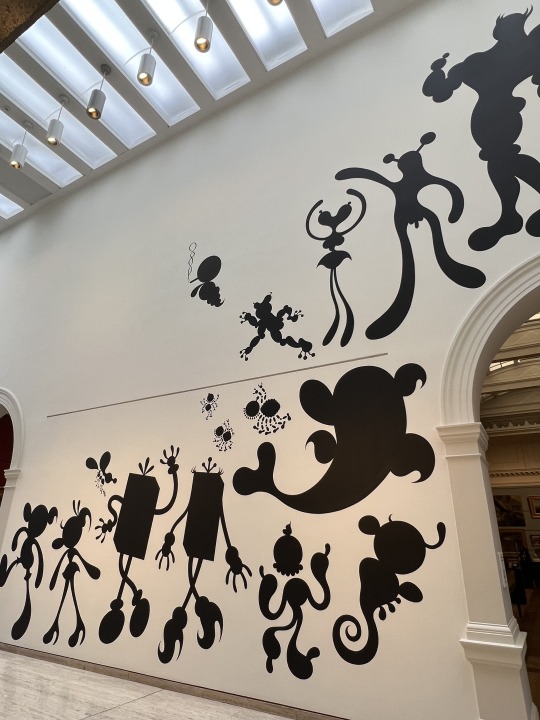
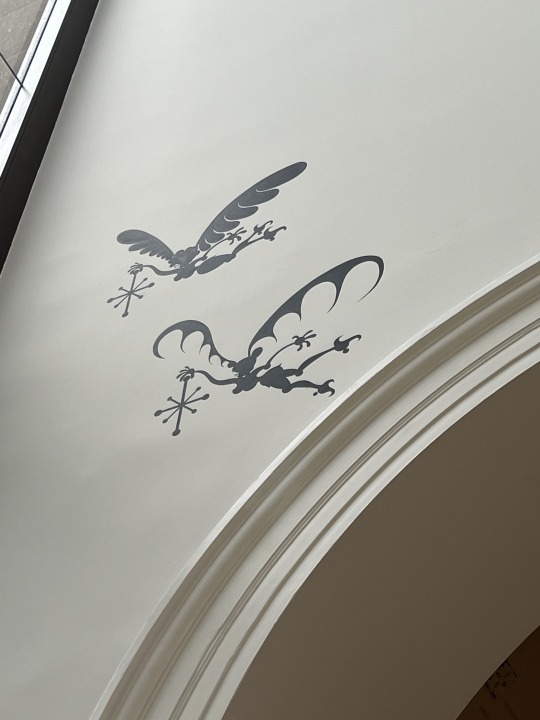
Description: "In Maru Yacco's Sydney parade, silhouetted figures appear like a troupe of dancers on a stage. Playing with ideas of
hyper-masculinity and exaggerated femininity, the characters act as avatars.
Yacco creates worlds full of whimsical, gender-fluid characters, informed by Japanese popular and subcultures. Often delving into ideas around genderless reproduction and alternative family structures, Yacco - a prominent figure in the Japanese trans community - challenges assumptions while reflecting on contemporary ideas of identity construction in the age of social media."
Robert Gabris' The Garden of Catastrophe series (pencil on paper)
From left to right: Becoming an Insect (2023), Deadly Nightshade (2023), In the Garden of Catastrophe (2023)
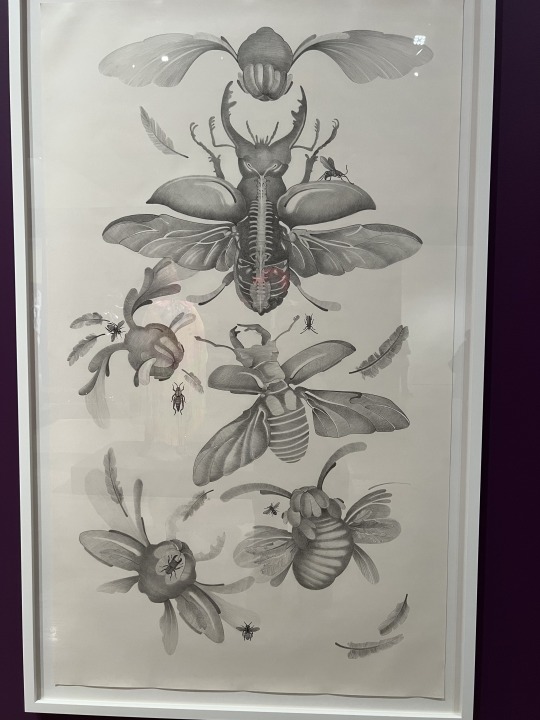

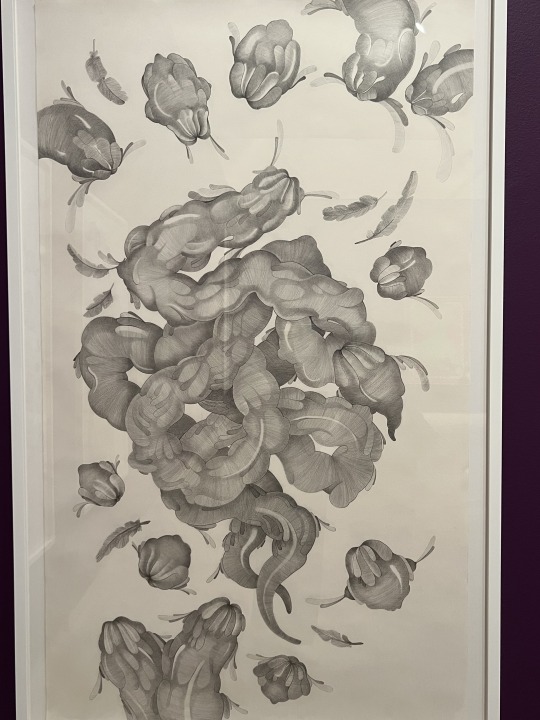
Description: "The series The Garden of Catastrophy is an expression of empowerment, symbolising the reclamation of agency over one's
own narrative and identity. Each drawing challenges centuries of
racism, discrimination and exoticisation experienced by the Roma
people throughout Europe to this day.
Pressing against heteronormative assumptions, Robert Gabris' drawings present a free-flowing identity more accepted within Roma culture. This self-described chaos isn't a force of destruction, but rather an agent of transformation and rebirth - a metaphor for the ever-evolving identities and stories of the marginalised.
Central to Gabris' work is a critique of the Eurocentric anthropological discourse that has historically objectified and dehumanised Roma bodies.
Through the fragmented portrayal of the queer Roma body, the drawings depict a garden of healing wherein the 'other' grows prodigiously. Symbolising ancestral wisdom, the insects that populate the garden navigate adversity with tenacity, just as the Roma people have endured the trials of history and colonisation."
Iratxe Jaio and Klaas Van Gorkum's False Flag (2021-2023, sculptural installation - polystyrene, fibreglass, epoxy resin and lacquer - and short film (5 mins 49 secs))
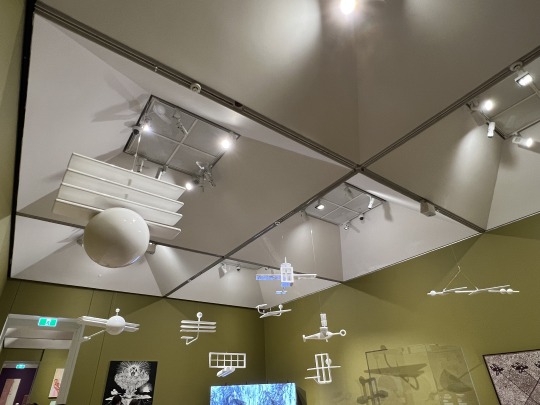
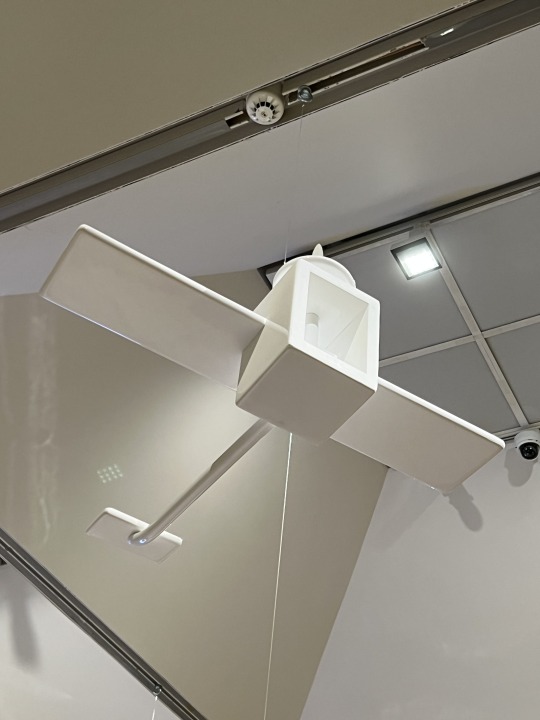


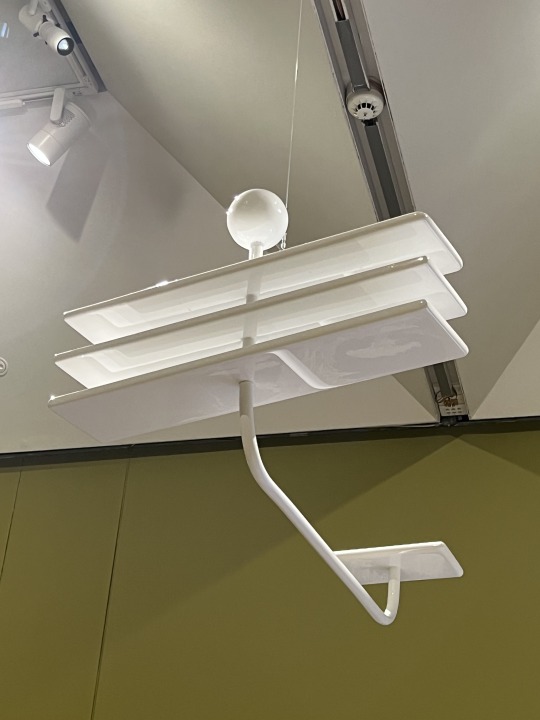
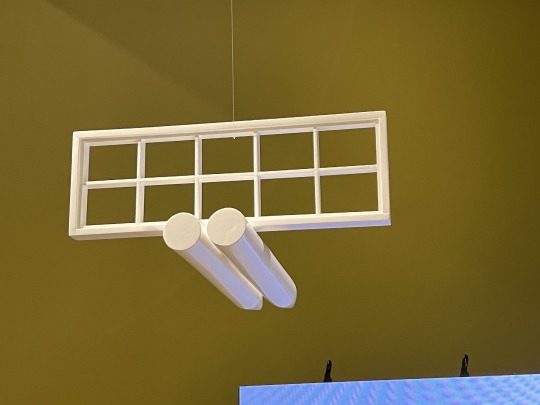

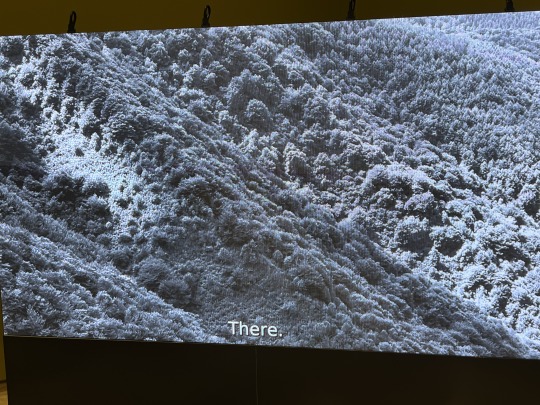
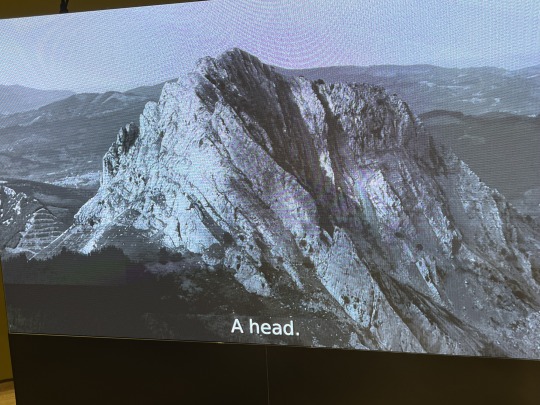


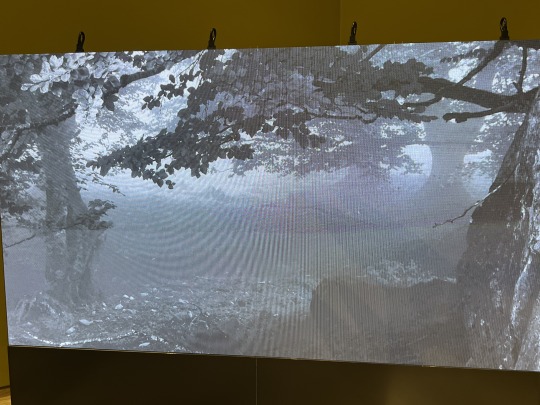
Description: "Taking inspiration from René Magritte's 1937 painting Le drapeau noir ('The black flag'), a response to the bombing of the Basque town of Guernica during the Spanish Civil War, Irate Jaio and
Klaas van Gorkum have re-created in 3D several of the work's futuristic airplanes. Appearing as if props from a science-fiction film, the planes foreshadow the advent of drone warfare and satellite
technology that define the contemporary era.
Gesturing at the ways in which technology fundamentally skews
human relationships with geography, Jaio and van Gorkum's False Flag is backgrounded by footage of the Basque mountains, and layered with ghostly and disparate voices listing body parts depicted in Pablo Picasso's Guernica 1937. Blurring ideas of the present, past and predictions for the future, False Flag considers how time and distance alter historical memory."
Bonita Ely's loctus works
Row 1: At home with the Locust People (Itchy feet) (1974-1975, oil paint and collage on canvas), At home with the Locust People (1974, acrylic paint on canvas)
Row 2: c20th Mythological Beasts: At home with the Locust People (1975, mixed media installation and short film (19 mins))
(Mild content warning for some censored artistic nudity)

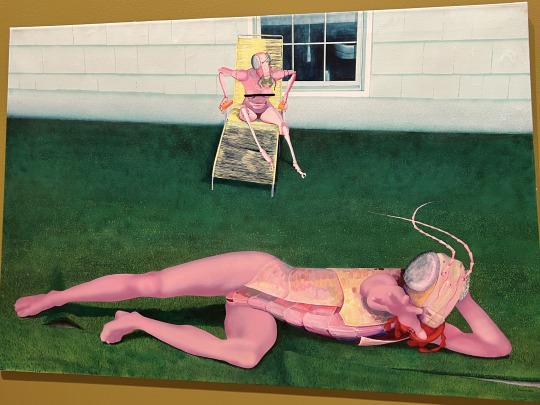
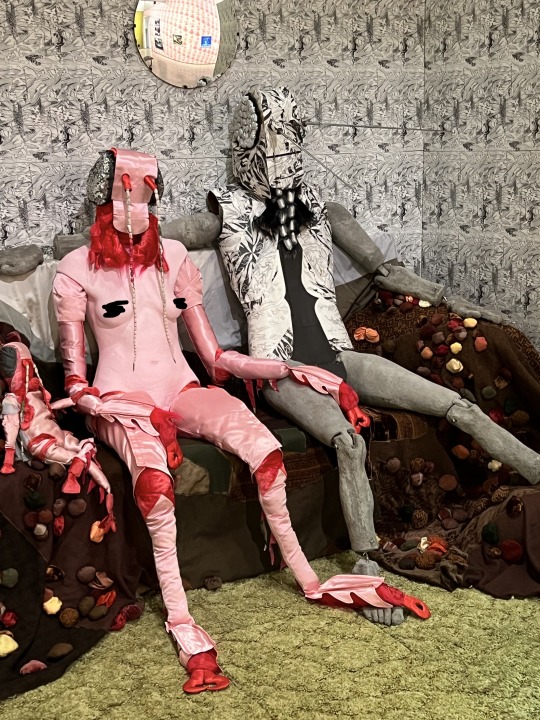

Description: "From the deserts of Ancient Egypt and the outcroppings of North America's Rocky Mountains to Australia's drought-ridden plains, locust swarms have devastated harvests, communities and entire landscapes. This biblical phenomenon - a sign of great punishment or the end of times - is scientifically referred to as the 'gregarious phase' whereby solitary locusts congregate in heaving, mass-producing and ravenous swarms.
For Bonita Ely, who explores themes of environmental degradation
in her art, there is an apt correlation between the gregarious phase
of locusts and the relationship humans have with the natural world.
Created in the 1970s when questions surrounding population and
pollution were reaching a fever pitch, the 'Locust People' works depict modern domestic scenes populated by vulgar human-insect
hybrids. In each, the Locust People have left their surroundings
either bare or smouldering, yet remain unbothered by anything except one another.
Ely's grim prediction of future environmental collapse positions humans as both the victim and the perpetrator. In c20th Mythological Beasts: At home with the Locust People, a nuclear family reclines, unfazed, while watching scenes of a dying world on television.
Like a locust swarm, humanity will not stop until there is nothing left to consume."
Nádia Taquary's beaded headdresses EG03 (yellow - 2021, Ipe wood, 70-degree bronze, fabric, and African cowrie shells) and EG05 (red/purple - 2021, Ipe wood, 70-degree bronze, glass beads imported from Czech Republic, Nigerian amber, and gourds)

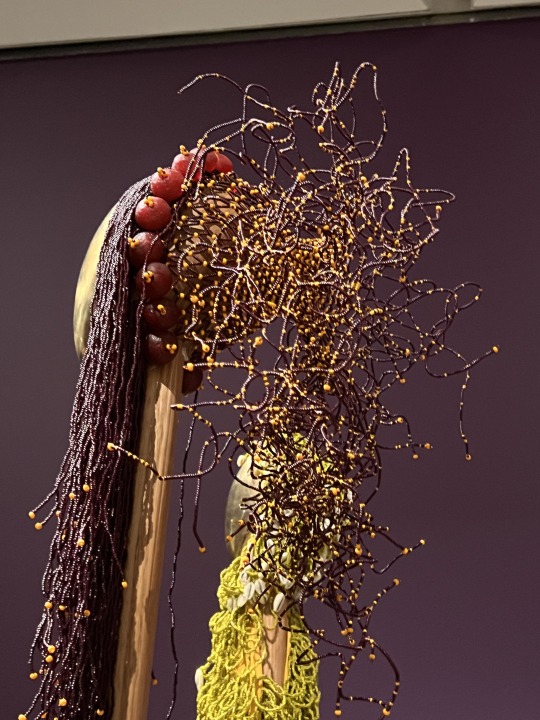
More info (not from Biennale description):
Pauline and Jim Yearbury's carved Rimu wood (c. 1967-1975)
From left to right: Tu Matauenga, Tawhirimatea, Rongo Mare Roa, Warrior Slaying Taniwha, How Maui Made The Sun Slow Down, Hinemoa & Tutanekai
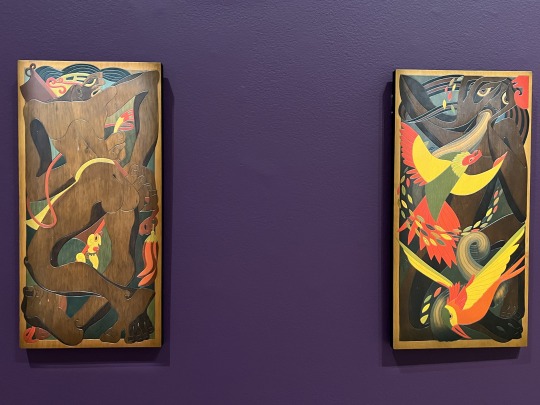


Description: "An important practitioner in Maori modernist art, Pauline Yearbury was dedicated to the preservation of ancestral knowledge. In 1943, she became one of the first two Mãori women to study at Elam School of Fine Art, Auckland, and would go on to spend much of her career tutoring younger artists.
In collaboration with her husband Jim Yearbury, Pauline Yearbury
created incised Rimu wood panels detailing the swirling stories
which constitute a rich Mãori mythology, the back of each labelled with a description of the scene it depicts. From tales of love and
war to the movement of the sun, Yearbury has captured the intricacies of her culture by combining traditional Mäori carving
with her geometricised forms."
0 notes
Text
Art Studio 1 Excursion: ArtSpace, AGNSW and MCA - PART 2 (10.5.24)
MCA: 24th Sydney Biennale
Juan Davila's oil paintings
Row 1: Untitled (2021), Untitled (2023)
Row 2: Untitled (2021), After Image Wilderness (2010)




Description: "Asked why he chose painting, Juan Davila once
answered, 'An enjoyment … does not need explanation. Over an artistic career spent lacerating political figures, government policy and state control, the artist has indeed consistently refused to explain himself.
From the outset, Davila's paintings have unflinchingly interrogated cultural, sexual and social identities, taking cues from popular culture, political discourse and mythology to create a complex and
provocative body of work. Born in Chile, Davila moved to Naarm/Melbourne in 1974 after the fall of the socialist Allende government. However, his work does not suggest what 'should be', instead richly-illustrating the joys, anxieties, shames and triumphs of the contemporary moment. Psychological and psychoanalytic themes are often present, but the artist refuses to articulate or reveal a clear position, prompting us to question our own biases."
Freddy Mamani
Left to right: Diablada (2024, wood coated in gloss enamel), Salon Gallo de Oro (2024, maquette)


Description: "For the past 15 years, Aymaran architect Freddy
Mamani has been designing and building Cholets, a combination of the French word 'chalet' and 'cholo', a reappropriated term once used to disparage those of indigenous descent in Bolivia. Interrupting the
monotony of the existing cityscape with his vibrant and distinct neo-Andean style, each Cholet recalls the colours, designs and patterning unique to the Aymara culture. The title Diablada, in particular, recalls the Danza de los Diablos, an Andean cultural dance characterised by performers wearing carnivalesque costumes of trickster devil characters.
Neo-Andean architecture largely emerged during the presidency, from 2006 to 2019, of Evo Morales, who was Bolivia's first indigenous leader in the country's 200-year history. It can be seen as a consequence of both his economic policies, which empowered a generation of Aymara business people, and of the sense of pride he instilled in the country's indigenous majority.
Designed specifically for the needs of the Aymaran people, each Cholet is three to seven storeys high and follows the same essential layout; the ground floor is dedicated to commercial activities, the
middle floors to cultural events, while the upper floors are residences. In this way, each Cholet develops and sustains its own economy. As Mamani says, 'this architecture has its own language, its own culture, its own identity'."
Left to right: Sergey Parajanov's The Colour of Pomegranates, (Out-takes and camera tests) (1969, film installation - colour film), Frank Moore's Lullaby (1997, oil on canvas with red pine frame)


Description of Parajanov's The Colour of Pomegranates: "The Colour of Pomegranates follows the 18th-century ashug (poet, singer) Sayat-Nova from his time in Georgia's royal court, love affair with a princess, consequent expulsion and journey across the Caucasus, to his death in a monastery. Transcending both traditional narrative and national boundaries to draw inspiration from across the region, much like Sayat-Nova's songs, the film recalls a series of Persian or Armenian illuminated miniatures. Created in the years following filmmaker Sergey Parajanov's disavowal of social realism and before his 1973 arrest by Soviet authorities under false charges, it contains references to the endurance of cultures across the South Caucasus region (Armenia, Azerbaijan, Georgia, as well as Ukraine) in the face of Soviet oppression.
Re-edited by Sergei Yutkevich, a key figure of the avant-garde during the 1920s, his version balanced Parajanov's poetic style with the Gosfilmofond's (Russia's state film archive) demands to make the
film more accessible. Thanks to documentary filmmaker Daniel Bird and the National Cinema Center of Armenia, the unseen out-takes from The Colour of Pomegranates were presented at the International Film Festival Rotterdam in 2019. Over a hundred
canisters of out-takes have survived despite the Soviet authorities blocking its distribution. Such film would typically have been recycled rather than preserved. Starring Sofiko Chiaureli, who plays six characters, The Colour of Pomegranates left a lasting impact on the film industry and survives as a testament to the power of poetry as a form of resistance across centuries."
Description of Moore's Lullaby: "Ernest Hemingway once suggested that each person dies twice, once when they pass away and again
when the last person to remember them forgets.
However, if someone is forgotten before they die, then it might feel as if they never existed. This was the reality for those who lived through the AIDS crisis. For years, as people became sick and died
America's gay community was ignored by the media and government.
Painter and activist Frank Moore, who at 48 died with HIV/AIDS, created Lullaby by transforming his own sick bed into a whimsical landscape populated by a herd of buffalo. Given US President Ronald
Reagan did not so much as utter the word AIDS until four years into the crisis, Moore suspected that his community, much like the endangered buffalo, was being left to become extinct. Drawing parallels between the AIDS epidemic and burgeoning ecological crises, Moore believed that this was an apocalypse for himself and those he loved."
Serwah Attafuah's Between this World & the Next (2023-2024, film installation - digital animation (3D computer-rendered models), and e-waste on wooden frame)






Description: "Serwah Attafuah's digital creation unfolds in a near-future Ghana, drawing viewers into an Afrofuturistic vista contrasting colonial remnants with utopian hope. The narrative, propelled by
burning slave castles, sinking colonial ships and formidable female warriors, weaves a tale that is both haunting and empowering. This work embodies Ghana's matrilineal legacy, while addressing contemporary issues like e-waste dumping, symbolised by a bespoke frame crafted from e-waste and the incorporation of Sakawa, or 'internet magic.
Responding to William Strutt's Black Thursday, February 6th, 1851, also on display, Attafuah delves into West African history, land rights and climate impact on its indigenous communities, fostering
a dialogue between historical reverence and visionary insight.
Through imaginative storytelling, Attafuah challeges conventional viewpoints and incites reflection, offering commentary on transcending historical bounds. Her avant-garde blend of cultural
reflections with futuristic aesthetics establishes this work as a conversation between past legacies and speculative horizons, towards a reimagined future."
BONUS: Maria Fernanda Cardoso's Butterfly Drawings - Morpho didius (Peru) (2004, archival butterfly wings, acrylic, silicone and metal)





Description: "First, I wanted to be a scientist but I used more the model of theRenaissance artist, like Leonardo, which was scientist and artist. So lwent into art thinking that I could do both, I could do art and science." - Maria Fernanda Cardoso
"Maria Fernanda Cardoso is renowned for her use of unconventional
materials, which often include symbolically charged elements from the natural world. ...a selection of the artist's butterfly drawings, featuring the insect's delicate wings arranged in mandala-like patterns. Underpinning these works is a system of geometry and repetition. The drawings invite us to look more closely and reflect on our complex relationship to the natural world."
0 notes
Text
Art Studio 1 Excursion: ArtSpace, AGNSW and MCA - PART 1 (10.5.24)
ArtSpace: 24th Sydney Biennale
Sana Shahmuradova Tanska's oil paintings
Row 1: Counteroffensive (2022), Apocalypse Survivors #7 (from
the Tethys Sea Inhabitants series) (2023), Don't Touch My Circles They Don't Belong to You (2023)
Row 2: Fiery Harvest (2023), Tired Sun, Delayed Sowing, Faithful Sheep (2022), Apocalypse Survivors #2 (from Tethys Sea Inhabitants series) (2023)
Row 3: Homesickness. (Stork) (2022), Untitled (2023), Apocalypse Survivors #1 (from the Tethys Sea Inhabitants series) (2023)
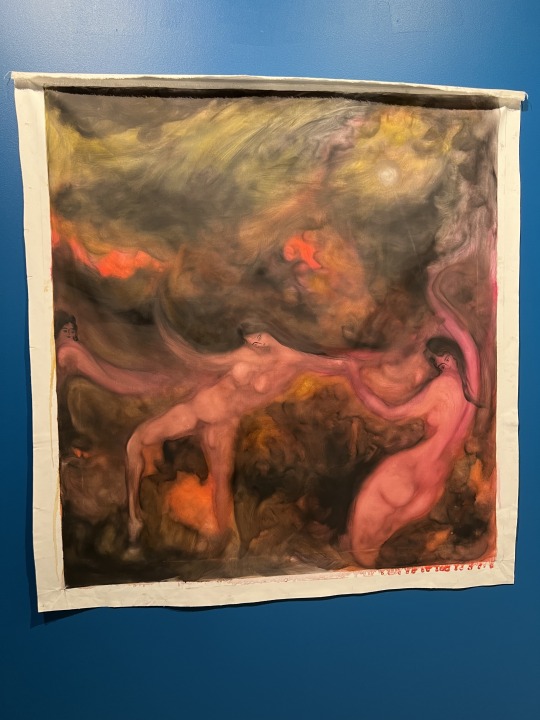


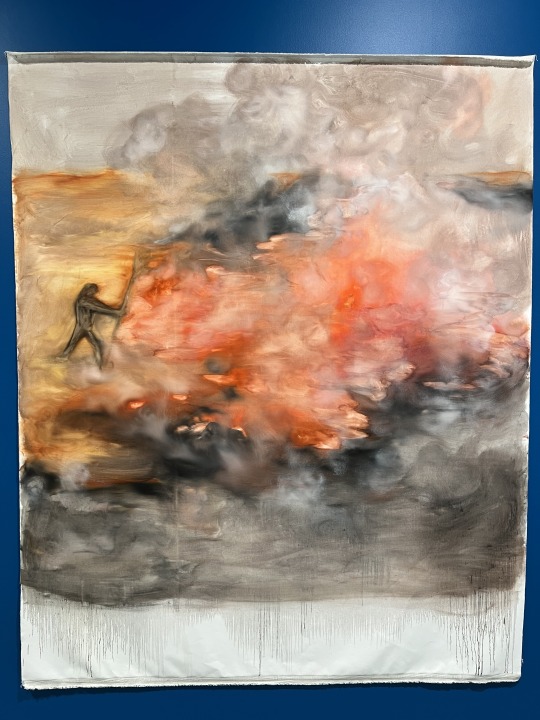



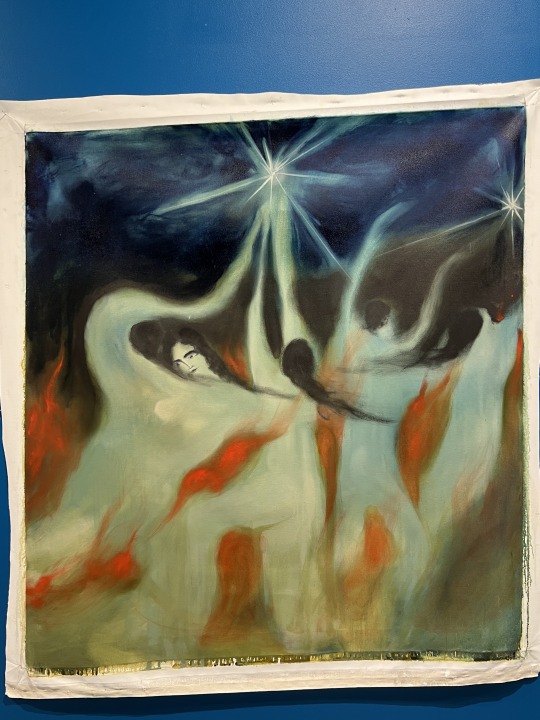

Description: "After spending seven years in Canada, Sana Shahmuradova Tanska returned to Ukraine in 2020, to live and paint from Kyiv... Rendered in oil paint, watercolour and pastel, the poetry and pain of intergenerational trauma floats across a war zone on an ocean of colour. Drawing on Ukrainian history and folklore for inspiration, Shahmuradova Tanska's dreamy figures inhabit a molten landscape of collective memory, grief and violence.
In the wake of the full-scale invasion of Ukraine in February 2022 - a continuation of a much longer history of occupation, [conflict] and cultural oppression - like a pebble thrown in still water, with each ringed ripple an echo of the one that came before it, Shahmuradova Tanska believes the distance between past and present traumas is collapsing.
In the Those who survived the apocalypse/The inhabitants of the Tethys series, the artist considers the Black Sea as a site of both connection and destruction. Like the limestone that surrounds it, the region's history is constantly undergoing erosion, environmental, colonial and cultural. Much the same way small shells remain, present in limestone dams and caves, so too are stories preserved.
Created between shelling attacks, which sent Shahmuradova Tanska to Cold War shelters plastered with old atomic war posters, these paintings stand as a testament to a people who have been pummeled by waves of occupation and invasion but remain as steadfast as the tide."
Trevor Yeung
Row 1: Cuddle Party (Two groups) (2024, Serpulorbis roussaei, vitrine, and found objects)
Row 2: Night Mushroom Colon (Artspace) (2024, night lamps, artificial plants and plug adaptors)

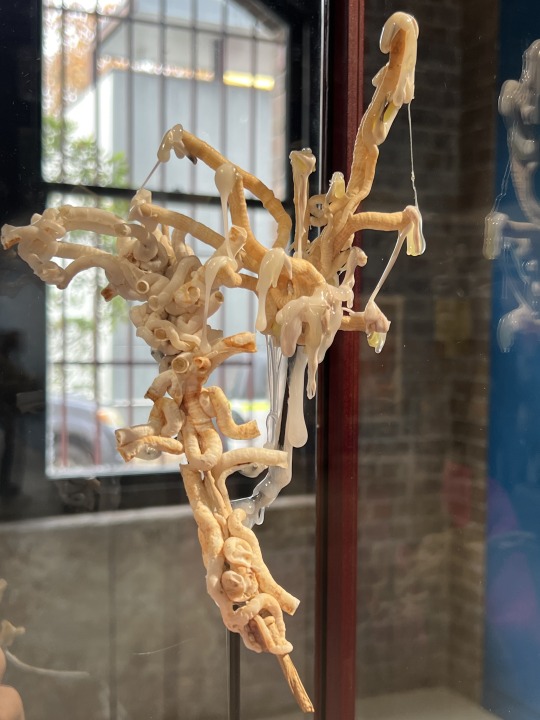

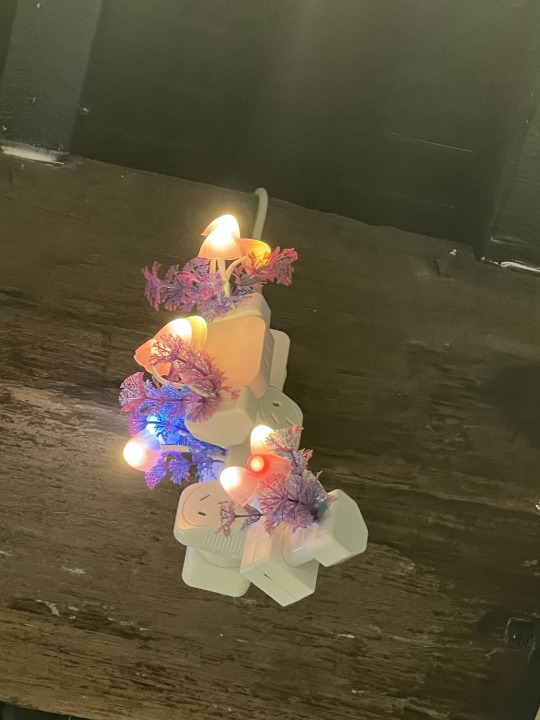
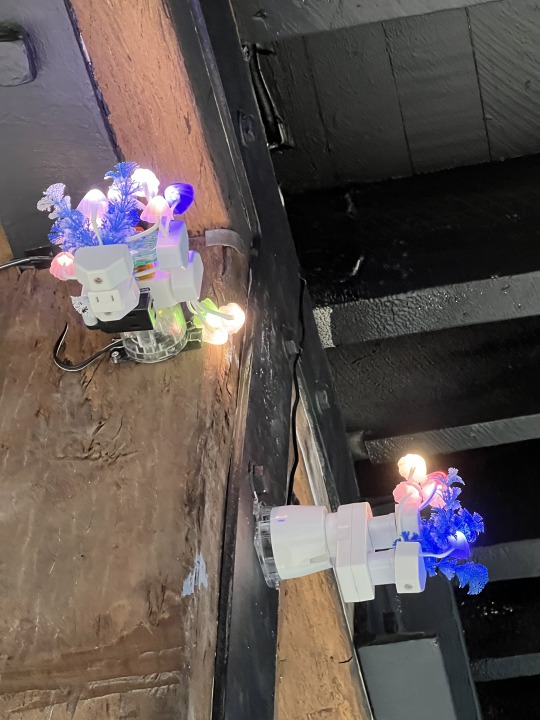
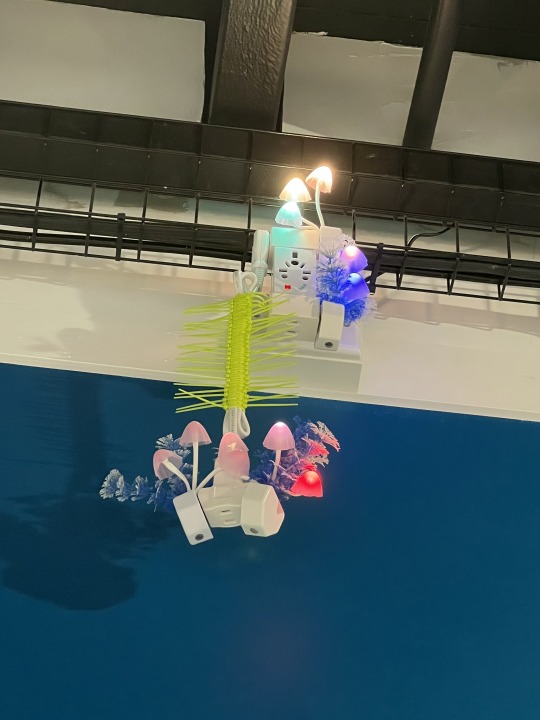
Description: "Trevor Yeung had grown up with many household pets, but during his time living in a college dormitory, where pets were banned, he started caring instead for a carnivorous plant whose needs were both specific and demanding. Through this, Yeung realised how crucial it was to cultivate the precise conditions that sustain life. Currently, he is creatively focused on understanding how social conditions shape emotional engagement. His practice ranges from image-based work to large- scale installations, creating structures that allow him to explore the power dynamics between living beings, including plants, animals, as well as the viewers. Using his installations as cyphers for his own emotional reality, Yeung often reveals the artificiality of perceived natural' connection.
In Cuddle Party (Two groups) Yeung transforms seashells into a shrine for love and relationships. Much how some may fill a vitrine with treasured objects or a small statue of a god, the work is a
dedication to romantic fantasies. At once sweet and intimate, it is underwritten by ideas of worship and what the artist describes as "a situation of taking sides".
Nearby Night Mushroom Colon (Artspace) combines electrical converters and nightlights to give off a gentle bioluminescence barely noticeable to a casual passerby. Appearing to grow almost secretly, these mushrooms thrive and reproduce independently through "polyamorous converters and tempting colours", in Yeung's words. Their apparent disinterest in, and distance from, human agency offers a viable alternative to the entanglement of human lives lived large, loudly and interdependently."
AGNSW: "What Does the Jukebox Dream of?"
In order from left to right: Callum Morton's Screen #7: Here and there (2006, wood and acrylic), Fiona Hall's Slash and burn (1997, 36 video boxes, 36 videotape sculptures and wire suspension grid), Paul Chan's Oh why so serious? (2008, 36 video boxes, computer keyboard, plastic and electronics)
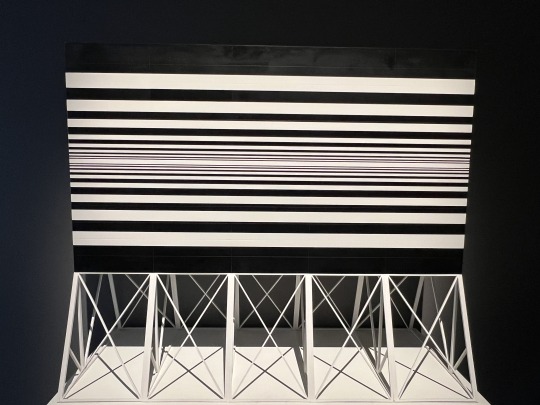

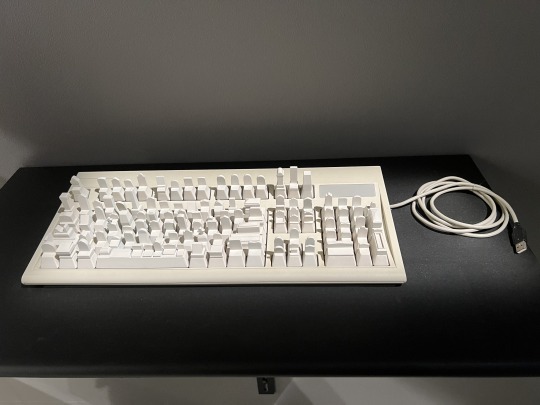
David Haines and Joyce Hinterdinge's The Outlands (2011, interactive software program, projector, colour,
sound, customised joysticks with twigs and table)

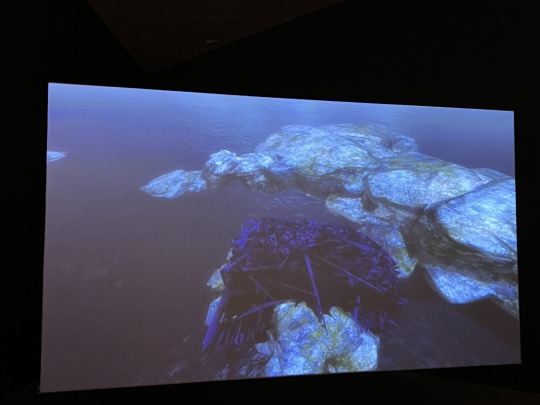

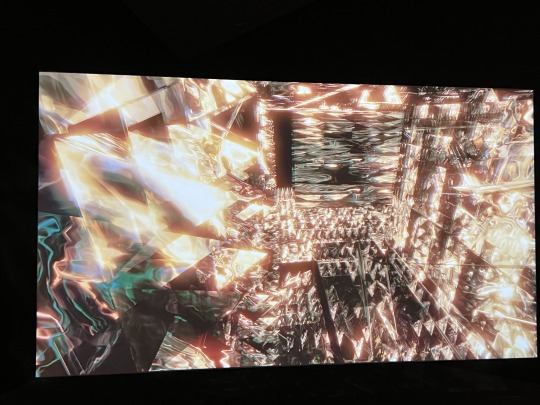
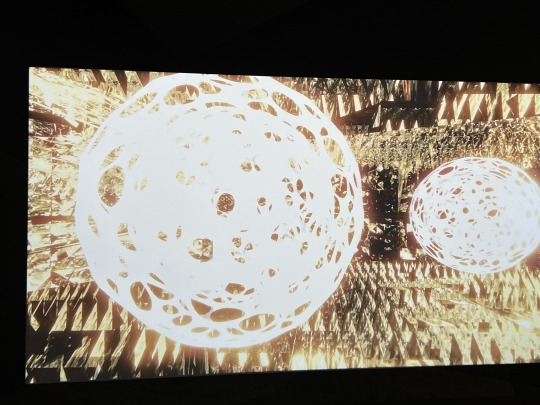
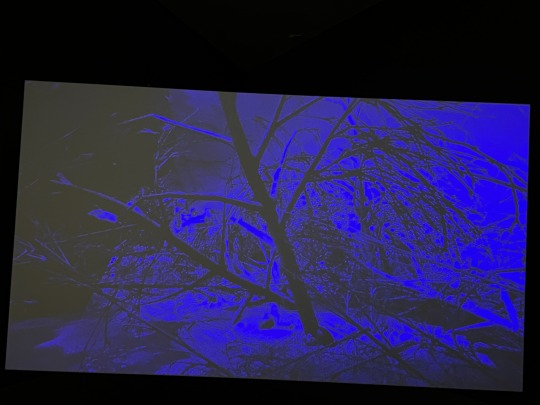
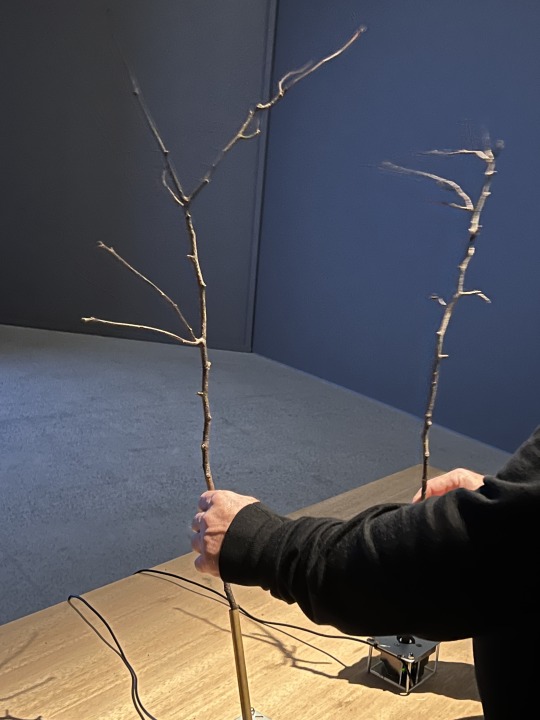
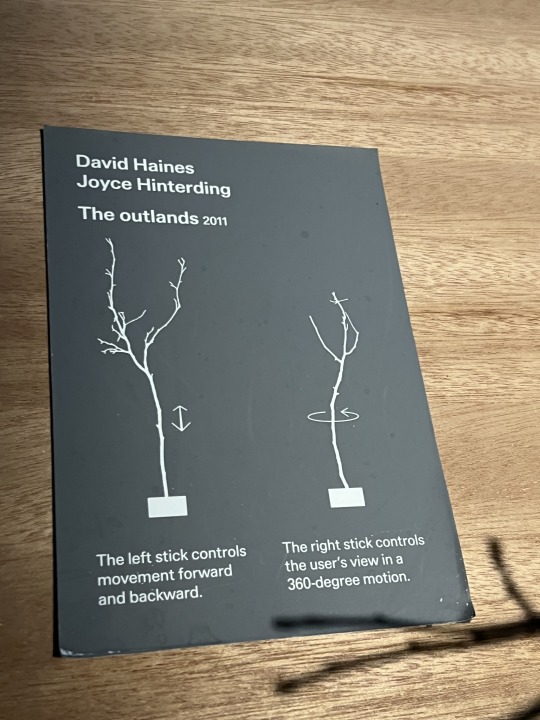
Description: "David Haines and Joyce Hinterding reimagine the
'natural' environment of video games. Experimenting with early gaming software, the pair hack code and alter in-built pre-sets - which assume first-person shooter mode - to conjure a digital universe devoid of weapons and violence. The logic of 'killing and winning' that guides many games is replaced here by an ethos
of unstructured, exploratory voyaging. Navigate crystal mazes and cyber seascapes with joysticks made of cherry blossom twigs. Search for the 'cracks' in the game's glitchy architecture to journey between worlds.
Don't worry: getting stuck in a digital swamp or freezing mid-teleport is all part of the fun of experiencing this innovative early-software-based artwork."
#sca projects#thingstonoteforfutureprojects#art gallery#year 3 art studio project 1#aa sca yr 3 sem 1 week 11
0 notes